brake YAMAHA YFZ450 2013 Owner's Manual
[x] Cancel search | Manufacturer: YAMAHA, Model Year: 2013, Model line: YFZ450, Model: YAMAHA YFZ450 2013Pages: 154, PDF Size: 3.77 MB
Page 76 of 154
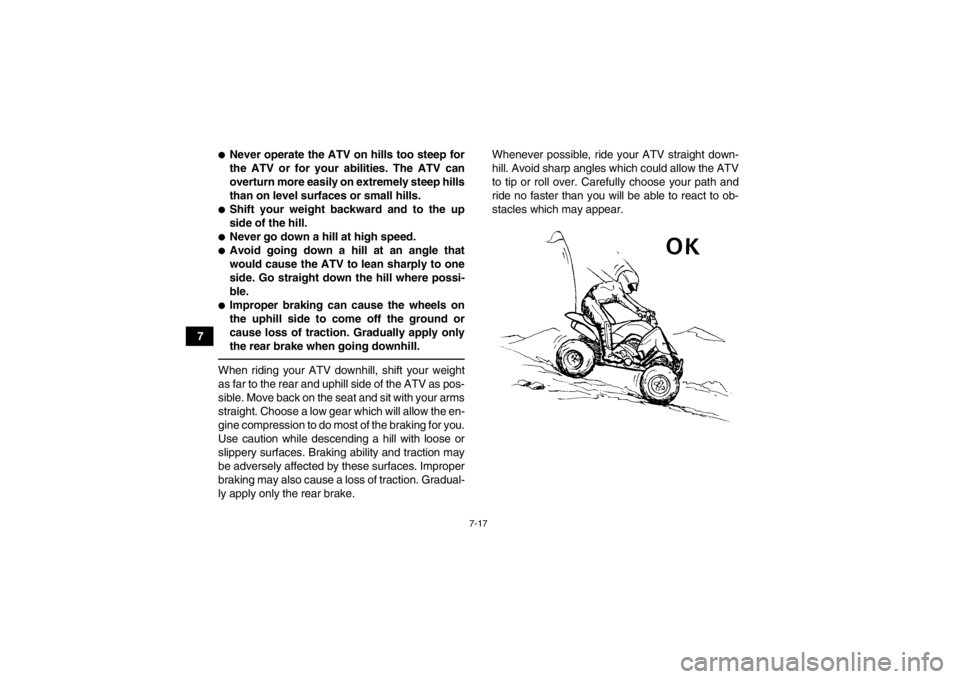
7-17
7
●Never operate the ATV on hills too steep for
the ATV or for your abilities. The ATV can
overturn more easily on extremely steep hills
than on level surfaces or small hills.●Shift your weight backward and to the up
side of the hill.●Never go down a hill at high speed.●Avoid going down a hill at an angle that
would cause the ATV to lean sharply to one
side. Go straight down the hill where possi-
ble.●Improper braking can cause the wheels on
the uphill side to come off the ground or
cause loss of traction. Gradually apply only
the rear brake when going downhill.When riding your ATV downhill, shift your weight
as far to the rear and uphill side of the ATV as pos-
sible. Move back on the seat and sit with your arms
straight. Choose a low gear which will allow the en-
gine compression to do most of the braking for you.
Use caution while descending a hill with loose or
slippery surfaces. Braking ability and traction may
be adversely affected by these surfaces. Improper
braking may also cause a loss of traction. Gradual-
ly apply only the rear brake.Whenever possible, ride your ATV straight down-
hill. Avoid sharp angles which could allow the ATV
to tip or roll over. Carefully choose your path and
ride no faster than you will be able to react to ob-
stacles which may appear.U1PD61E0.book Page 17 Tuesday, February 14, 2012 10:06 AM
Page 78 of 154
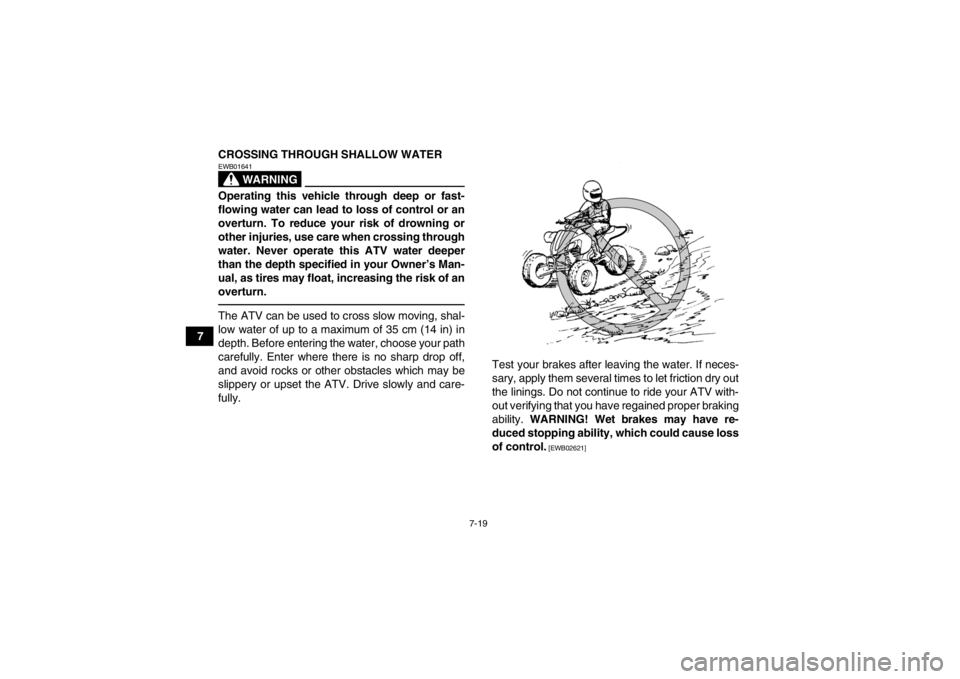
7-19
7CROSSING THROUGH SHALLOW WATER
WARNING
EWB01641Operating this vehicle through deep or fast-
flowing water can lead to loss of control or an
overturn. To reduce your risk of drowning or
other injuries, use care when crossing through
water. Never operate this ATV water deeper
than the depth specified in your Owner’s Man-
ual, as tires may float, increasing the risk of an
overturn.The ATV can be used to cross slow moving, shal-
low water of up to a maximum of 35 cm (14 in) in
depth. Before entering the water, choose your path
carefully. Enter where there is no sharp drop off,
and avoid rocks or other obstacles which may be
slippery or upset the ATV. Drive slowly and care-
fully.
Test your brakes after leaving the water. If neces-
sary, apply them several times to let friction dry out
the linings. Do not continue to ride your ATV with-
out verifying that you have regained proper braking
ability.
WARNING! Wet brakes may have re-
duced stopping ability, which could cause loss
of control.
[EWB02621]
U1PD61E0.book Page 19 Tuesday, February 14, 2012 10:06 AM
Page 80 of 154
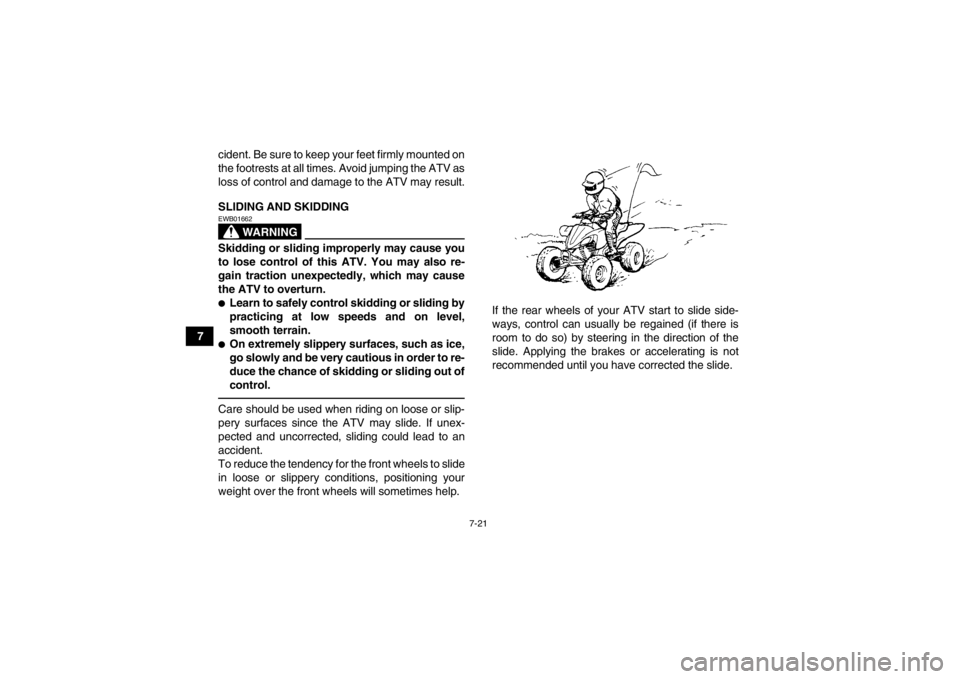
7-21
7cident. Be sure to keep your feet firmly mounted on
the footrests at all times. Avoid jumping the ATV as
loss of control and damage to the ATV may result.
SLIDING AND SKIDDING
WARNING
EWB01662Skidding or sliding improperly may cause you
to lose control of this ATV. You may also re-
gain traction unexpectedly, which may cause
the ATV to overturn.●Learn to safely control skidding or sliding by
practicing at low speeds and on level,
smooth terrain.●On extremely slippery surfaces, such as ice,
go slowly and be very cautious in order to re-
duce the chance of skidding or sliding out of
control.Care should be used when riding on loose or slip-
pery surfaces since the ATV may slide. If unex-
pected and uncorrected, sliding could lead to an
accident.
To reduce the tendency for the front wheels to slide
in loose or slippery conditions, positioning your
weight over the front wheels will sometimes help.
If the rear wheels of your ATV start to slide side-
ways, control can usually be regained (if there is
room to do so) by steering in the direction of the
slide. Applying the brakes or accelerating is not
recommended until you have corrected the slide.U1PD61E0.book Page 21 Tuesday, February 14, 2012 10:06 AM
Page 81 of 154
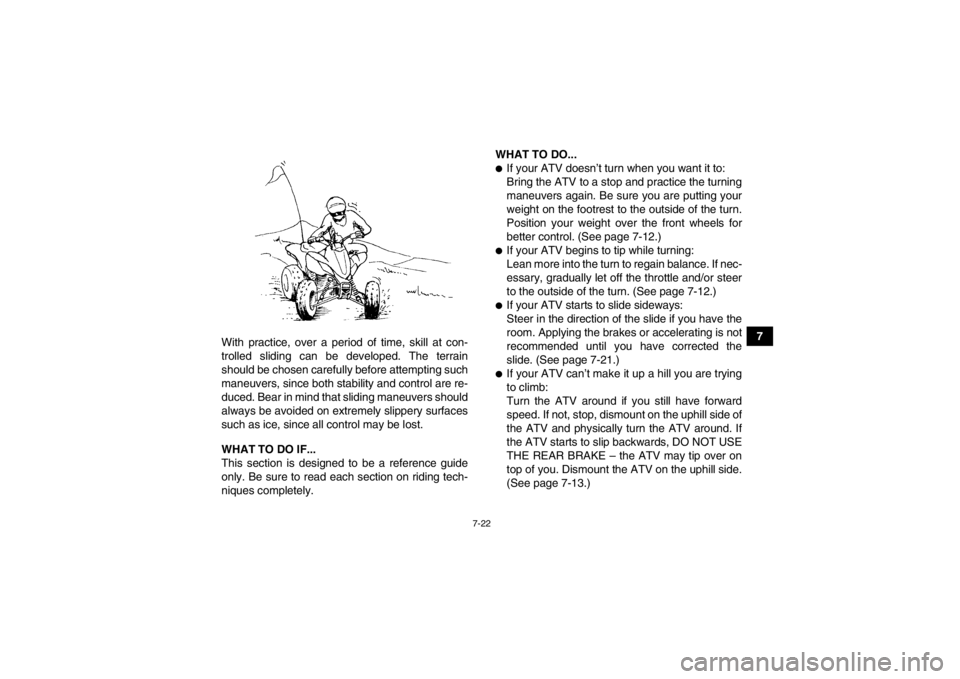
7-22
7
With practice, over a period of time, skill at con-
trolled sliding can be developed. The terrain
should be chosen carefully before attempting such
maneuvers, since both stability and control are re-
duced. Bear in mind that sliding maneuvers should
always be avoided on extremely slippery surfaces
such as ice, since all control may be lost.
WHAT TO DO IF...
This section is designed to be a reference guide
only. Be sure to read each section on riding tech-
niques completely. WHAT TO DO...
●If your ATV doesn’t turn when you want it to:
Bring the ATV to a stop and practice the turning
maneuvers again. Be sure you are putting your
weight on the footrest to the outside of the turn.
Position your weight over the front wheels for
better control. (See page 7-12.)●If your ATV begins to tip while turning:
Lean more into the turn to regain balance. If nec-
essary, gradually let off the throttle and/or steer
to the outside of the turn. (See page 7-12.)●If your ATV starts to slide sideways:
Steer in the direction of the slide if you have the
room. Applying the brakes or accelerating is not
recommended until you have corrected the
slide. (See page 7-21.)●If your ATV can’t make it up a hill you are trying
to climb:
Turn the ATV around if you still have forward
speed. If not, stop, dismount on the uphill side of
the ATV and physically turn the ATV around. If
the ATV starts to slip backwards, DO NOT USE
THE REAR BRAKE – the ATV may tip over on
top of you. Dismount the ATV on the uphill side.
(See page 7-13.)
U1PD61E0.book Page 22 Tuesday, February 14, 2012 10:06 AM
Page 82 of 154

7-23
7
●If your ATV is traversing a sloping surface:
Be sure to ride with your weight positioned to-
wards the uphill side of the ATV to maintain
proper balance. If the ATV starts to tip, steer
down the hill (if there are no obstacles in your
way) to regain balance. If you discover that the
ATV is going to tip over, dismount on the uphill
side. (See page 7-18.)●If your ATV encounters shallow water:
Ride slowly and carefully through slow moving
water, watching for obstacles. Be sure to let wa-
ter drain from the ATV and CHECK YOUR
BRAKES FOR PROPER OPERATION when
you come out of the water. Do not continue to
ride your ATV until you have regained adequate
braking ability. (See page 7-19.)
U1PD61E0.book Page 23 Tuesday, February 14, 2012 10:06 AM
Page 83 of 154
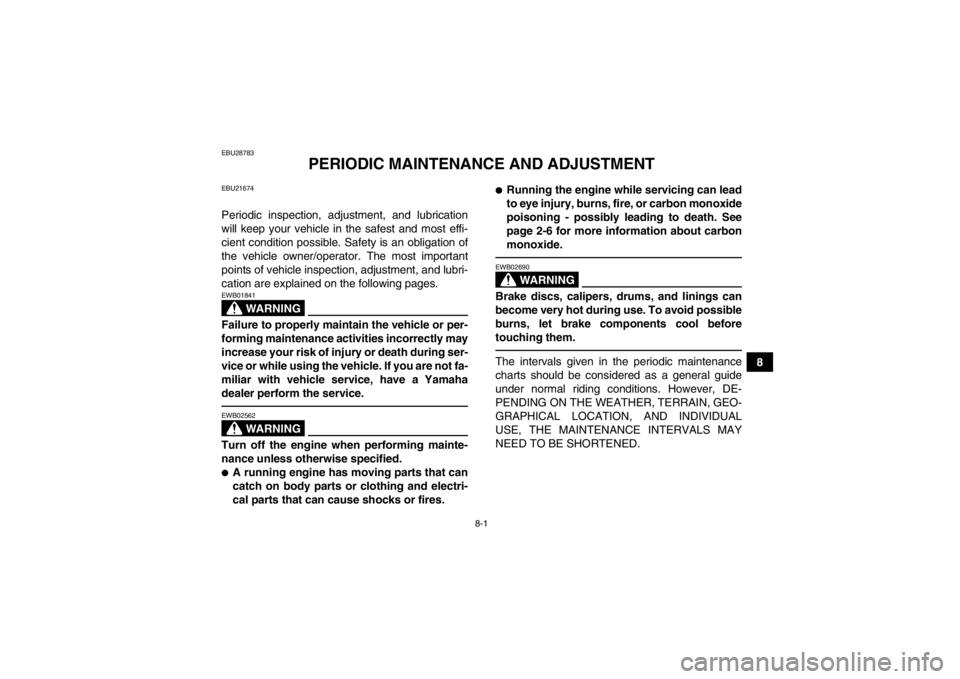
8-1
8
EBU28783
PERIODIC MAINTENANCE AND ADJUSTMENT
EBU21674Periodic inspection, adjustment, and lubrication
will keep your vehicle in the safest and most effi-
cient condition possible. Safety is an obligation of
the vehicle owner/operator. The most important
points of vehicle inspection, adjustment, and lubri-
cation are explained on the following pages.
WARNING
EWB01841Failure to properly maintain the vehicle or per-
forming maintenance activities incorrectly may
increase your risk of injury or death during ser-
vice or while using the vehicle. If you are not fa-
miliar with vehicle service, have a Yamaha
dealer perform the service.
WARNING
EWB02562Turn off the engine when performing mainte-
nance unless otherwise specified.●A running engine has moving parts that can
catch on body parts or clothing and electri-
cal parts that can cause shocks or fires.
●Running the engine while servicing can lead
to eye injury, burns, fire, or carbon monoxide
poisoning - possibly leading to death. See
page 2-6 for more information about carbon
monoxide.
WARNING
EWB02690Brake discs, calipers, drums, and linings can
become very hot during use. To avoid possible
burns, let brake components cool before
touching them.The intervals given in the periodic maintenance
charts should be considered as a general guide
under normal riding conditions. However, DE-
PENDING ON THE WEATHER, TERRAIN, GEO-
GRAPHICAL LOCATION, AND INDIVIDUAL
USE, THE MAINTENANCE INTERVALS MAY
NEED TO BE SHORTENED.
U1PD61E0.book Page 1 Tuesday, February 14, 2012 10:06 AM
Page 87 of 154

8-5
8
EBU21865General maintenance and lubrication chart TIP●For ATVs not equipped with an odometer or an hour meter, follow the month maintenance intervals.●For ATVs equipped with an odometer or an hour meter, follow the km (mi) or hours maintenance inter-
vals. However, keep in mind that if the ATV isn’t used for a long period of time, the month maintenance
intervals should be followed.●Items marked with an asterisk should be performed by a Yamaha dealer as they require special tools,
data and technical skills.NO.ITEM CHECK OR MAINTENANCE
JOB INITIAL
EVERY
Whichev- er comes first month136612
km
(mi) 320
(200) 1300
(800) 2500
(1600) 2500
(1600) 5000
(3200)
hours 20 80 160 160 320
1 Air filter element Clean and replace if necessary. Every 20–40 hours (more often in wet or
dusty areas)
2 *Clutch Check operation and adjust if necessary. √ √√√
3 *Front brake Check operation and correct if necessary.
Check fluid level and ATV for fluid leakage, and
correct if necessary. √√√√√
Replace brake pads. Whenever worn to the limit
4 *Rear brake Check operation and correct if necessary.
Check fluid level and ATV for fluid leakage, and
correct if necessary. √√√√√
Replace brake pads. Whenever worn to the limit
U1PD61E0.book Page 5 Tuesday, February 14, 2012 10:06 AM
Page 88 of 154

8-6
8
5*Brake hoses Check for cracks or other damage, and replace if
necessary. √√√√
Replace. Every 4 years
6 *Parking brake Check operation and adjust if necessary. √√√√√
7 *Wheels Check runout and for damage, and replace if nec-
essary. √ √√√
8 *Tires Check tread depth and for damage, and replace if
necessary.
Check air pressure and balance, and correct if necessary. √ √√√
9 *Wheel hub bearings Check for looseness or damage, and replace if
necessary. √ √√√
10 *Swingarm pivots Check operation and for excessive play, and re-
place bearings if necessary.
Lubricate with lithium-soap-based grease. √√√
11 *Upper and lower
arm pivots
Lubricate with lithium-soap-based grease.
√√√
12 Drive chain Check chain slack and adjust if necessary.
Check rear wheel alignment and correct if neces-
sary.
Clean and lubricate. √√√√√
13 *Drive chain rollers Check for wear and replace if necessary. √√√
NO. ITEM
CHECK OR MAINTENANCE
JOB INITIAL EVERY
Whichev- er comes first month136612
km
(mi) 320
(200) 1300
(800) 2500
(1600) 2500
(1600) 5000
(3200)
hours 20 80 160 160 320U1PD61E0.book Page 6 Tuesday, February 14, 2012 10:06 AM
Page 90 of 154

8-8
8
EBU23071TIP●Some maintenance items need more frequent service if you are riding in unusually wet, dusty, sandy or
muddy areas, or at full-throttle.●Hydraulic brake service
Regularly check and, if necessary, correct the brake fluid level.
Every two years replace the internal components of the brake master cylinders and calipers, andchange the brake fluid.
Replace the brake hoses every four years and if cracked or damaged.23 *Moving parts and
cables Lubricate.
√√√√
24 *Throttle lever Check operation.
Check throttle lever free play, and adjust if neces-
sary.
Lubricate cable and lever housing. √√√√√
25 *Front and rear brake
switches Check operation and correct if necessary.
√√√√√
26 *Lights and switches Check operation and correct if necessary.
Adjust headlight beams. √√√√√
NO. ITEM
CHECK OR MAINTENANCE
JOB INITIAL EVERY
Whichev- er comes first month136612
km
(mi) 320
(200) 1300
(800) 2500
(1600) 2500
(1600) 5000
(3200)
hours 20 80 160 160 320U1PD61E0.book Page 8 Tuesday, February 14, 2012 10:06 AM
Page 114 of 154
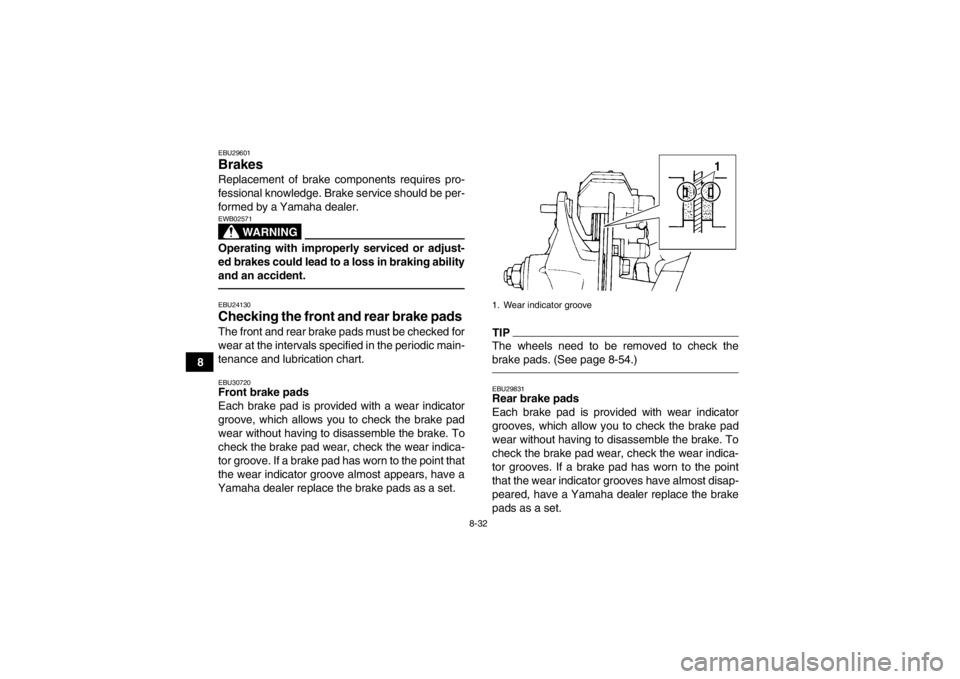
8-32
8
EBU29601Brakes Replacement of brake components requires pro-
fessional knowledge. Brake service should be per-
formed by a Yamaha dealer.
WARNING
EWB02571Operating with improperly serviced or adjust-
ed brakes could lead to a loss in braking ability
and an accident.EBU24130Checking the front and rear brake pads The front and rear brake pads must be checked for
wear at the intervals specified in the periodic main-
tenance and lubrication chart.EBU30720Front brake pads
Each brake pad is provided with a wear indicator
groove, which allows you to check the brake pad
wear without having to disassemble the brake. To
check the brake pad wear, check the wear indica-
tor groove. If a brake pad has worn to the point that
the wear indicator groove almost appears, have a
Yamaha dealer replace the brake pads as a set.
TIPThe wheels need to be removed to check the
brake pads. (See page 8-54.)EBU29831Rear brake pads
Each brake pad is provided with wear indicator
grooves, which allow you to check the brake pad
wear without having to disassemble the brake. To
check the brake pad wear, check the wear indica-
tor grooves. If a brake pad has worn to the point
that the wear indicator grooves have almost disap-
peared, have a Yamaha dealer replace the brake
pads as a set.1. Wear indicator groove
U1PD61E0.book Page 32 Tuesday, February 14, 2012 10:06 AM